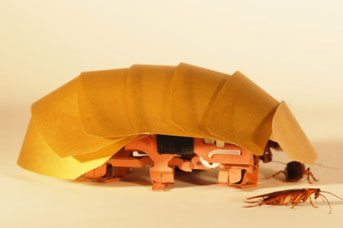The fact that that U.S. cockroaches (Periplaneta americana) can ooze their way into rooms or cupboards through the smallest cracks, and hide in tiny crevices, freaks Americans out on some primal level. That the critters can then run at top speed, even when flattened out, is just bug icing on the cake.
But to one researcher, that’s just amazing engineering worthy of repeat in rescue robots hunting through rubble for survivors of earthquakes, tornadoes, and other disasters.
“What’s impressive about these cockroaches is that they can run as fast through a quarter-inch gap as a half-inch gap, by reorienting their legs completely out to the side,” says Kaushik Jayaram, Ph.D., a UC Berkeley grad now a postdoctoral fellow at Harvard University. “They’re about half an inch tall when they run freely, but can squish their bodies to one-tenth of an inch — the height of two stacked pennies.” Roaches running along crevices can survive and navigate up to 900 times their body weight without harm.
Inspired by the bug, Jayaram came up with a cheap, palm-sized robot that when squished can splay its legs outward. He capped it with a plastic shield, to mimic the wings covering a roach’s back. The result is CRAM, for compressible robot with articulated mechanisms. The bastard can wiggle into and traverse crevices half its height.
“In the event of an earthquake, first responders need to know if an area of rubble is stable and safe, but the challenge is, most robots can’t get into rubble,” said Robert Full, a professor of integrative biology at UC Berkeley. “But if there are lots of cracks and vents and conduits, you can imagine just throwing a swarm of these robots in to locate survivors and safe entry points for first responders.”
Jayaram built the model robot using an origami-like manufacturing technique, now available as an inexpensive kit made by Dash Robotics — a commercial spin-off from previous robotic work at UC Berkeley. Now, more robust versions will be needed for real-world testing.
“This is only a prototype, but it shows the feasibility of a new direction using what we think are the most effective models for soft robots, that is, animals with exoskeletons,” Full said. “Insects are the most successful animals on earth. Because they intrude nearly everywhere, we should look to them for inspiration as to how to make a robot that can do the same.”


